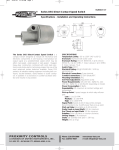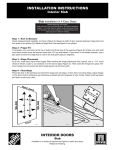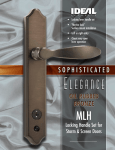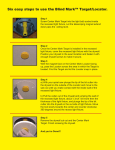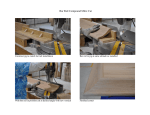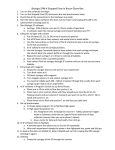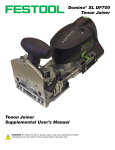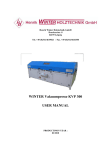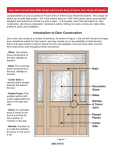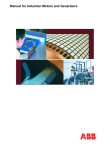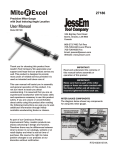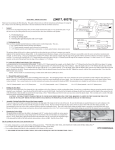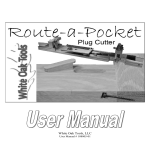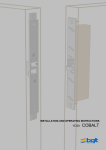Download User`s Manual - The Woodshop
Transcript
User's Manual Revision-D COPYRIGHT © 2007-2008 BY R.G. Jig Co. WARNING: NO PORTION OF THIS MANUAL MAY BE REPRODUCED IN ANY SHAPE OR FORM WITHOUT THE WRITTEN APPROVAL OF R.G. Jig Co. Mortise Pal™ Mortising Jig User's Manual Mortise Pal™ allows you to make precision slot mortises with your plunge router. Please take the time to thoroughly read this manual and familiarize yourself with how the jig is used as well as the jig's safety precautions. Kit Contents: As shown in Fig. 1, the jig is supplied with: ● (1) Jig Body ● (4) Mortising Templates ● (1) Doweling Template ● (1) 5/8” Template Guide Bushing* with Nut and Centering Pin ● (1) 3/32” Hex Key *Note: The supplied template guide bushing fits Porter Cable style base plates. Check your users manual. Others will require a universal base plate adapter (not included). Fig. 1: Kit Contents 1 Mortise Pal™ Mortising Jig User's Manual Required Items: To use the jig you will be required to supply: ● A light duty plunge router with a 6” base plate. These routers are generally 2-1/4 horsepower or less and weigh less than 12 pounds. The jig is not designed for and should not be used with heavy duty plunge routers. Various factors such as their overall size, weight, and center of gravity make heavy duty plunge routers unsuitable for use with this jig. ● A router bit. Spiral up-cut bits are recommended as they remove waste from the mortise while routing. Safety: To operate this or any tool safely and efficiently, it is essential to become as familiar as possible with its characteristics. Take as much time as necessary to become familiar with the jig. Also, read and follow all of the safety procedures noted in this manual. If you do not understand any of the operations or safety guidelines discussed in this manual, please get answers to all your questions before attempting to use the jig by emailing [email protected] or calling 619-459-7951. Read, understand, and follow all of the safety instructions that were included with your plunge router. This jig should only be use with a plunge router. Never use the jig with a fixed base router. The jig is designed to be used with plunge routers that have base plates that 2 Mortise Pal™ Mortising Jig User's Manual are at least 6” in diameter. Referring to Fig. 2, your plunge router's base plate must be supported by by the jig's fence and the jigs clamping bracket at all times during use. Before using the jig, check to see that your plunge routers base plate is supported by the Fig. 2: Your plunge router base plate is supported by the jig's fence and clamping bracket. fence and clamping bracket with the template positioned anywhere along the guide rods. If your base plate is not supported by the jigs fence and the jigs clamping bracket do not use the jig as this can create problems with your joinery, damage the jig or create an unsafe situation. Referring to Fig. 3, some base plates completely are circular not or have an offset clearance hole or both. Care must be taken when using these plunge routers to ensure that the widest Fig. 3: Some base plates are non-circular or have offset clearance holes. 3 Mortise Pal™ Mortising Jig User's Manual portion of the plate is at least 6” and maintains contact with the jigs fence and clamping bracket at all times as shown in Fig. 4. Proper stock holding is essential for the safe use of the jig. Your stock must be held securely with clamps, in a woodworkers vise, or by other suitable means. Stock that is not properly secured could Fig 4: Use widest portion of plate when it is not circular or has an offset clearance hole. move while routing, creating an unsafe situation or damaging the jig. 4 Mortise Pal™ Mortising Jig User's Manual When using a woodworker's vise avoid clamping the jig to your stock as shown in Figures 5 and 6. The jig is shown clamped to the stock with too much distance between the jig and the vise jaws. Forces generated from routing could leverage the stock Fig 5: Unsafe Vise Setup. and cause it to move. Fig. 6: Unsafe Vise Setup. 5 Mortise Pal™ Mortising Jig User's Manual Figures 7 and 8 illustrate a safer setup when clamping stock in a woodworkers vise. The stock has been repositioned so that the jig is closer to the vise jaws. Forces generated from routing are less likely to leverage the stock. Fig. 7: Safe Vise Setup. Fig. 8: Safe Vise Setup. 6 Mortise Pal™ Mortising Jig User's Manual Specifications: Referring to Fig. 9: ● The minimum stock is width 1”. Your stock needs to be at least 1” wide to Fig. 9: Stock and mortise specifications. be securely clamped in the jig. ● The minimum stock thickness is 3/4”. Note, mortises may be made in thiner stock by using shims. ● The maximum stock thickness is 3”. ● The maximum mortise width is 1/2” as determined by the largest bit to fit through the 5/8” outside diameter template guide bushing. ● The mortise length is determined by the template used and the diameter of the router bit used. Referring to Fig. 10, the template length is measured from center to center along the slot. The mortising templates supplied with the jig come in four lengths, 1/2”, 1”, 1-1/2” and 2”. ● To determine the overall mortise length add the template length to the bit diameter. Fig. 10: Template Specifications. For example, 7 Mortise Pal™ Mortising Jig User's Manual the 1” template used with a 3/8” bit produces a 1-3/8” mortise. The same template used with a 1/4” bit produces a 1-1/4” mortise. Table 1 can be used to determine the overall mortise length for common sized router bits. Note, by overlapping mortises it is possible to create mortises Template Length (in) 1/2 1 1 1/2 2 Bit Diameter (in) 3/4 1 1/4 1 3/4 2 1/4 1/4 Mortise Length (in) 13/16” 7/8 1 5/16” 1 3/8 1 13/16” 1 7/8 2 5/16” 2 3/8 5/16” 3/8 1 1 1/2 2 2 1/2 1/2 Table 1: Mortise length equals template length plus bit diameter. of virtually any length. Referring again to Fig. 8, the template width is 41/64”, or 1/64” larger than the 5/8” template guide bushing. This small space between the bushing and the template allows you to rout the mortise by moving your router around the template thereby producing a mortise with an excellent surface finish on the walls. Just remember that your finished mortise will be 1/64” larger than the bit diameter. Using the Jig: Using the jig generally requires the following five steps: 1. Install the template guide bushing. 2. Select and install a template. 3. Make layout lines on your stock. 4. Set up the jig. 5. Rout the mortise. 8 Mortise Pal™ Mortising Jig User's Manual Step 1. The template guide bushing includes a centering pin that allows you to install it perfectly concentric plunge your routers Referring insert with to the collet. Fig. 11, appropriate end of the centering pin into your plunge routers 1/4” or 1/2” collet. Tighten the collet. Then Install the guide template bushing by placing it into the counter bore of your plunge Fig. 11: Template Guide Bushing, Nut and centering Pin. router's base plate. Thread the nut onto the template guide bushing, but do not completely tighten the nut. Plunge the centering pin through the bushing so that the center portion of the pin mates with the inside diameter of the bushing. Lock your plunge router at this depth and tighten the nut. Then retract the centering pin and remove it. The template guide bushing is now installed perfectly concentric with your plunge routers collet. 9 Mortise Pal™ Mortising Jig User's Manual Step 2. Referring to Fig. 12, select a template and then install it by first removing the brass screws. Use the 3/32” hex key that was included with the jig. Place the template onto the template block so that the holes in the template mate with the corresponding dowel pins on the template block. Press down firmly to ensure that the holes in the template mate with the dowel pins. Carefully replace the brass screws. To remove the template, remove the screws, insert brass your Fig. 12: Install template by removing brass screws and placing template over dowel pins index finger into the slot on the template and pull it off of the template block. Step 3. Make layout lines on your stock that mark the center of the mortise. Fig 13 shows the completed layout lines on a leg blank before the mortise has been routed. 10 Mortise Pal™ Mortising Jig User's Manual Step 4. Setting up the jig will require centering the template over the layout lines. Referring to Fig. 14, hold the jig's fence against your stock. Align the centerline mark on the side of the jig with the first layout line as shown. When the centerline mark and the layout line coincide, turn the thumb screw to lock the template in place. Fig. 13: Make layout lines marking the center of the mortise. Fig. 14: Align centerline mark with first layout line. 11 Mortise Pal™ Mortising Jig User's Manual Referring to Fig. 15 align the centerline pointer with the second layout line. Then turn the clamping knob so that the secured stock is to the with the template over jig the centered layout lines. Fig. 15: Align centerline pointer with second layout line. Step 5. Proceed to rout the mortise. Referring to Fig. 16, one technique for routing the mortise is to make a series of overlapping plunges to full depth along the length of the template. Then make a finishing cut by moving your plunge router around the template. This technique is fast and produces a mortise Fig. 16: Overlapping plunge cuts. 12 with an excellent surface Mortise Pal™ Mortising Jig User's Manual finish on the walls. Note, waste chips will accumulate while routing the mortise. You may need to periodically stop routing and remove this waste. A shop vacuum works well. Maintenance: The jig requires very little maintenance. To remove dust and debris from the jig use compressed air, a soft bristle brush or a dry rag. Periodically place a drop of lubricant or tool oil on the four stainless steel guide rods. Warranty: R.G. Jig Co. stands behind its products with a one-year limited warranty. If you have any questions regarding the warranty you can contact Customer Service by email at [email protected] or by calling 619-459-7951. Coverage: R.G. Jig Co. warrants that this product is free of defects in factory workmanship and materials during normal use. If this product fails during normal use because of such a defect, R.G. Jig Co. will, at its option, repair or replace, free of charge, any part or parts shown to be so defective. Excluded from Coverage: Failure resulting from alteration, modification, misuse, abuse or neglect or after repairs have been attempted or made by others. 13















